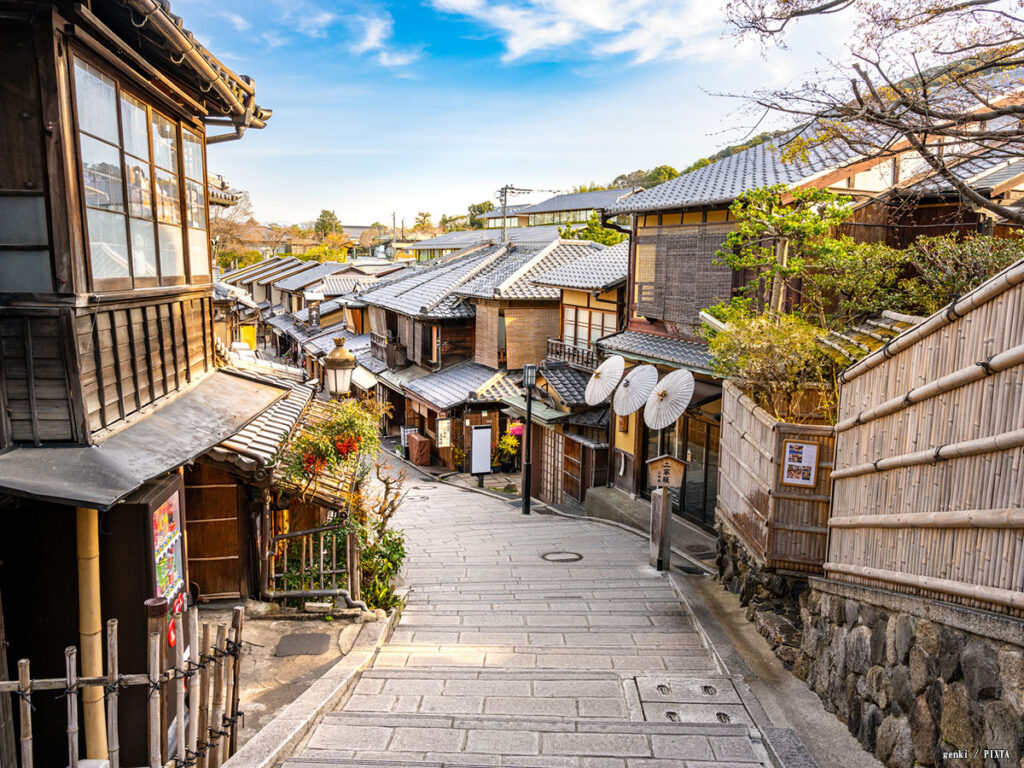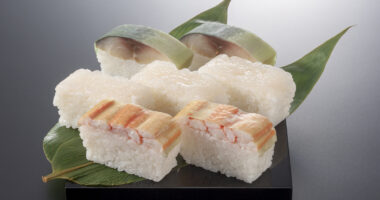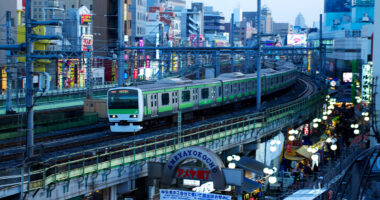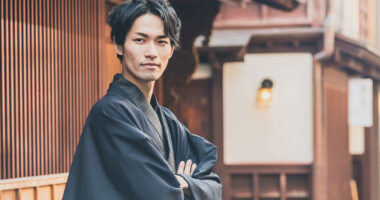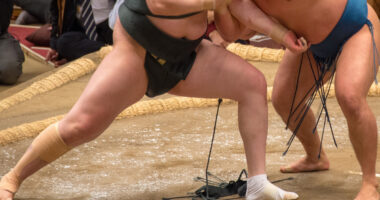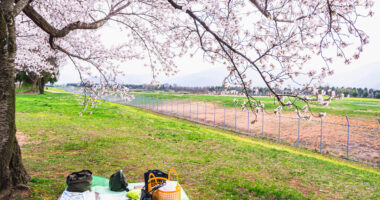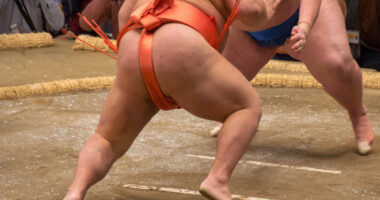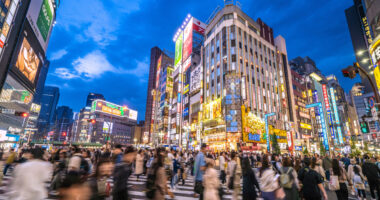The first time you step onto Ninenzaka and Sannenzaka, it feels like you’ve wandered into another era. The stone-paved paths slope gently downward, flanked by beautifully preserved machiya townhouses, their wooden facades whispering stories of Kyoto’s past.
The air carries a faint aroma of freshly whisked matcha, mingling with the sweet scent of yatsuhashi, a local delicacy often featuring cinnamon. Somewhere in the distance, the soft twang of a shamisen drifts through the narrow alleyways, blending seamlessly with the murmur of visitors dressed in flowing yukata, pausing to admire the view or snap a photo against the backdrop of traditional tea houses.
Wandering these old streets of Kyoto, every turn reveals something new—an artisan meticulously painting delicate Kyō-yaki ceramics, a tiny shop selling Kyoto’s famed handcrafted furoshiki (traditional Japanese wrapping cloth), or a quiet tea house where time seems to slow down with each sip of rich, velvety matcha. Ninenzaka and Sannenzaka are not just streets; they are a living, breathing remnant of Kyoto’s Edo-period charm.
If you’re planning to visit, this Ninenzaka Sannenzaka walking guide will help you make the most of your experience. From the finest souvenirs to the most inviting cafés, here’s everything you need to know about exploring Kyoto’s most picturesque old town. Whether you’re searching for handcrafted ceramics, Kyoto-exclusive sweets, or a serene spot to unwind with a warm bowl of matcha, these historic streets offer something special at every step.
Why visit Ninenzaka & Sannenzaka?
As you make your way through Kyoto, leaving behind the neon-lit streets of modern shopping districts, the atmosphere shifts. The hum of city life fades, replaced by the quiet charm of Ninenzaka and Sannenzaka, where time-honored traditions still thrive. These gently sloping paths have guided visitors toward Kiyomizudera Temple for centuries, and today, they remain one of the most enchanting pockets of Kyoto’s old town.
Here, the past isn’t just preserved—it’s woven into everyday life. The wooden machiya storefronts, some standing for generations, house carefully curated shops filled with handcrafted treasures. No factory-made souvenirs here—only artisanal ceramics, delicate furoshiki cloths, and Kyoto-exclusive sweets that reflect the city’s deep-rooted craftsmanship. Whether it’s a hand-thrown tea bowl glazed in muted earth tones or a beautifully wrapped box of matcha confections, everything carries a sense of place, a touch of Kyoto’s heritage. For first-time visitors, these streets are more than just a scenic walk—they’re an experience. Ninenzaka and Sannenzaka belong on every Kyoto itinerary, offering a glimpse into a world where tradition is not only remembered but actively lived.
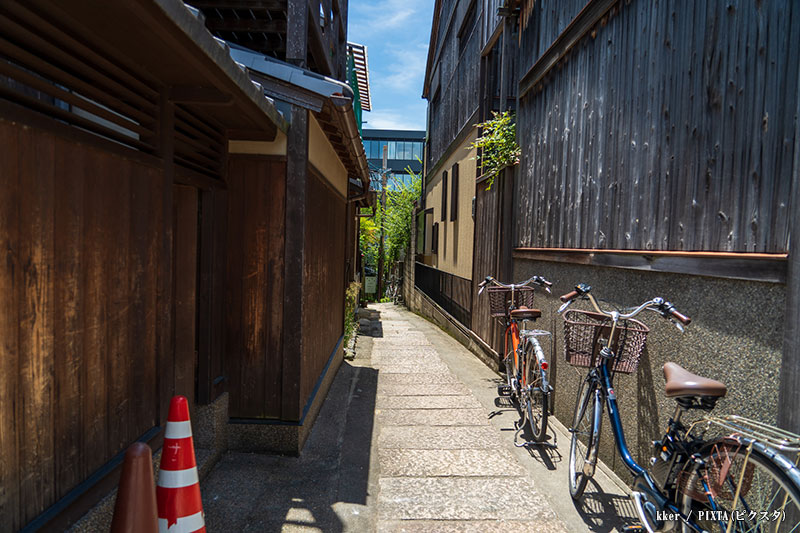
Photo for illustrative purposes
Best souvenirs to buy on Ninenzaka & Sannenzaka
Walking through Ninenzaka and Sannenzaka, it’s easy to feel as though you’ve stepped into a different era. These charming lanes, part of Kyoto’s old town, are a treasure trove of handcrafted goods, traditional sweets, and unique finds that you won’t encounter in the city’s more modern shopping districts.
This Ninenzaka Sannenzaka Walking Guide will introduce you to some of the finest souvenirs that capture the essence of Kyoto—whether you’re looking for elegant ceramics, delicious wagashi, or beautifully designed textiles.
If you’re searching for something special to take home, the old streets of Kyoto have plenty to offer. Here’s a look at the best souvenirs you can find along these historic paths.
Kyo-yaki and Kiyomizu-yaki Ceramics – a piece of Kyoto in your hands
There’s a certain magic in holding a piece of Kyoto’s ceramic craftsmanship. Unlike mass-produced pottery, Kyo-yaki and Kiyomizu-yaki are created with extraordinary attention to detail. The artisans behind these pieces have spent years perfecting their craft, producing ceramics that are both functional and artistic.
Wandering through Ninenzaka and Sannenzaka, you’ll notice shopfronts displaying exquisite tea bowls, sake cups, and delicate plates, each with a design that reflects Kyoto’s rich traditions. One of the best places to find these handcrafted treasures is Asahido, a shop that has been selling fine Kyoto ceramics for over 140 years. Whether you’re looking for a minimalist yunomi teacup or an ornate, hand-painted plate, this shop offers some of the most authentic pottery in the region.
What makes Kyo-yaki and Kiyomizu-yaki so sought after? Their refinement. These ceramics are known for their lightweight yet sturdy nature, elegant glazes, and intricate hand-painted details that often depict Kyoto’s seasonal beauty. A tea set from these historic streets isn’t just a souvenir—it’s a piece of Kyoto’s artistic legacy that you can take home.
Asahido
Address: 1-280 Kiyomizu, Higashiyama-ku, Kyoto, Kyoto Prefecture, Japan
Business Hours: 9:30 AM – 6:00 PM (Hours may be extended during special night visits at Kiyomizu-dera)
Closed Days: Open year-round
Website: https://www.asahido.co.jp/en/
Kyoto sweets – a taste of the seasons
A visit to Kyoto’s historic streets wouldn’t be complete without trying wagashi, traditional Japanese, and other sweets that beautifully embody the changing seasons. In Kyoto, sweets are not just desserts—they are artfully crafted confections designed to complement the flavors of matcha tea.
One of the most popular places to sample Kyoto’s delicate sweets is Malebranche, a renowned confectionery famous for its Cha no Ka matcha langue de chat cookies. These crisp, buttery green tea flavored cookies are sandwiched with a layer of white chocolate, offering the perfect balance of sweetness and bitterness. It’s no surprise that they are one of the most sought-after souvenirs in Kyoto.
Kyoto’s wagashi reflect the city’s dedication to craftsmanship and seasonality. Whether you’re indulging in a sweet treat on the spot or bringing home an elegantly packaged box, these delicacies offer a true taste of Kyoto.
Although it’s not in the Ninenzaka or Sannenzaka area, you can visit Malebranche’s main store for a good selection:
Malebranche Kitayama Main Store
Address: Kitayama Street, in front of the North Gate of the Botanical Garden, Kita-ku, Kyoto 603-8053, Japan
Closed Days: None
Business Hours:
Shop: 9:00 AM – 5:30 PM
Salon: 10:00 AM – 5:30 PM (Last Order: 5:00 PM)
Concierge Room: 9:00 AM – 5:00 PM
Parking: 9 dedicated spaces + additional partner parking available (Click here for details)
Website: https://www.malebranche.co.jp.e.aby.hp.transer.com/
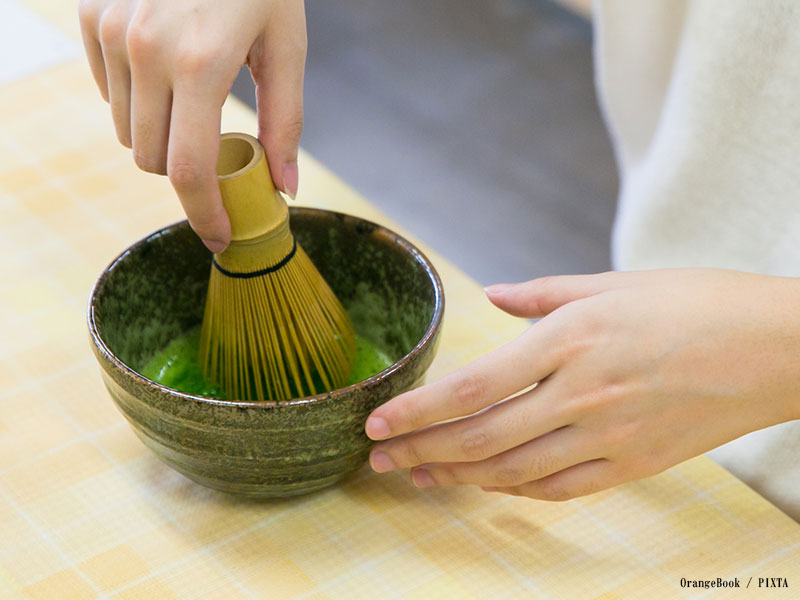
Photo for illustrative purposes
Handmade furoshiki – the art of Japanese elegance
One of the most versatile and uniquely Japanese souvenirs you can find in Kyoto’s old town is the furoshiki,a beautifully designed wrapping cloth used to carry items, wrap gifts, or even serve as a fashion accessory. More than just fabric, furoshiki represents Japan’s commitment to sustainability and artistry.
For the best selection, stop by Musubi Furoshiki, a specialty shop in Kyoto offering a wide range of locally made furoshiki, from traditional motifs to modern, minimalist designs. What makes this store special is that the staff provide live demonstrations of different folding and wrapping techniques, showing you how a simple square of fabric can transform into a stylish bag or an elegant gift wrap.
A furoshiki isn’t just a souvenir—it’s a way to incorporate Japanese culture into your everyday life. Whether you use it to wrap a lunchbox, carry a book, or decorate your home, this Kyoto souvenir combines beauty and practicality in a way that’s both meaningful and eco-friendly.
Musubi Furoshiki
Address: 67 Masuya-chō Higashi-iru, Sakai-machi Sanjō-dōri, Nakagyō-ku, Kyoto
Closed Days: Open year-round (Special closures during summer and New Year’s holidays)
Business Hours: 11:00 AM – 7:00 PM
Website: https://www.musubi-furoshiki.com/
Kyoto-exclusive skincare annd fragrances – timeless beauty and serenity
Kyoto is renowned for its dedication to craftsmanship, which extends beyond temples and textiles into the world of beauty and fragrance. If you’re looking for unique, locally made skincare and incense, Kyoto’s historic streets are home to some incredible finds.
Yojiya – the secret to flawless skin
One of the most famous beauty brands in Kyoto is Yojiya, beloved for its aburatorigami (oil blotting papers). Originally used by Kyoto’s geisha to maintain their flawless makeup, these ultra-thin blotting papers are now a must-have for keeping skin fresh and shine-free throughout the day. In addition to its signature blotting papers, Yojiya also offers a luxurious matcha-infused skincare line, featuring antioxidant-rich creams and cleansers that nourish the skin.
Address: 334-3 Kiyomizu, Higashiyama-ku, Kyoto City, Japan (Inside Seiryu-en)
Business Hours: 9:00 AM – 6:00 PM (Open daily, hours may vary by season or social conditions)
Access:
By Bus from JR Kyoto Station: Take the city bus and get off at “Kiyomizu-michi” bus stop. Approx. 10-minute walk.
Website: https://www.yojiya.co.jp/en/
Shoyeido Incense – over 300 years of Japanese aromatics
For a sensory experience, visit Shoyeido Incense, a historic shop crafting handmade incense for over 300 years. Some of their incenses capture the essence of Kyoto’s old town with delicate notes of various aromas you’ll surely appreciate. Whether you’re looking to create a calming atmosphere at home or searching for a unique Kyoto souvenir, traditional Japanese incense is a timeless treasure.
Shoyeido Incense
Website: https://www.shoyeido.co.jp/english/
Cafés you shouldn’t miss in Ninenzaka and Sannenzaka
Exploring the old streets of Kyoto isn’t just about shopping for souvenirs—it’s also about slowing down and soaking in the atmosphere. Tucked between traditional machiya townhouses and souvenir shops, you’ll find some of the most charming cafés in Kyoto. Whether you’re looking for a rich cup of hand-brewed coffee, a delicate matcha parfait, or an authentic Japanese tea experience, these cafés offer a perfect place to pause and take in the beauty of Ninenzaka and Sannenzaka.
As you wander through these historic streets, here are three must-visit spots that serve more than just great drinks—they offer a taste of Kyoto’s timeless charm.
If there’s one café in Ninenzaka and Sannenzaka that coffee lovers shouldn’t miss, it’s % Arabica in Kyoto. Originally founded in Kyoto before expanding across the world, this coffee shop has gained a cult following for its smooth, meticulously crafted espresso and stunning locations. Their Ninenzaka branch is particularly special—situated on a picturesque slope, it offers one of the most scenic coffee spots in Kyoto, with a direct view of the historic streets below.
Step inside, and you’ll immediately notice the minimalist interior, where everything reflects the brand’s dedication to quality. Their signature Kyoto Latte is a must-try. If you prefer something bold, their single-origin drip coffee is an excellent way to experience the pure flavors of their carefully selected beans.
But what truly sets this café apart is the experience of sipping a hot cup of coffee while standing outside, watching people stroll along Kyoto’s old town in their elegant yukata. Whether you’re a casual coffee drinker or a devoted enthusiast, % Arabica in Kyoto offers an unforgettable coffee break in one of the most beautiful corners of the city.
Saryo Tsujiri – Kyoto’s ultimate matcha dessert haven
If Kyoto had a matcha capital, Saryo Tsujiri would be at the heart of it. This legendary café is famous for its rich Uji matcha desserts, making it a paradise for anyone who loves the deep, earthy bitterness of high-quality green tea.
With a store located in the heart of Gion, just a short walk from Kyoto’s scenic Ninenzaka and Sannenzaka streets, this café is the perfect place to take a break after a day of exploring Kyoto’s old town.
Indulge in Kyoto’s best matcha treats
The moment you step inside, the aroma of freshly whisked matcha fills the air. The menu is a celebration of green tea in all its forms, featuring:
- Matcha lattes and parfaits – A creamy, bittersweet delight.
- Anmitsu – A traditional Japanese dessert bowl with sweet red beans, jelly cubes, and matcha ice cream.
Sitting in this cozy café with a bowl of beautifully layered matcha parfait, you’ll experience the harmony of Kyoto’s tea culture. And if you want to take a piece of it home, their selection of high-grade matcha powders makes for an excellent Kyoto souvenir.
Whether you’re a lifelong matcha lover or trying it for the first time, Saryo Tsujiri offers an authentic taste of Kyoto’s tea tradition in the heart of its old town.
Saryo Tsujiri
Address: 573-3 Gionmachi Minamigawa, Shijo-dori, Higashiyama-ku, Kyoto, Japan
Business Hours:
10:30 AM – 8:00 PM (Last order for soft serve: 7:00 PM)
Closed: Irregular holidays (subject to change)
Access:
By Train: 3-minute walk from Exit 6 of Gion-Shijo Station (Keihan Railway) along Shijo Street
By Bus: Get off at Gion Bus Stop
Parking: Not available
Website: https://www.giontsujiri.co.jp/en/
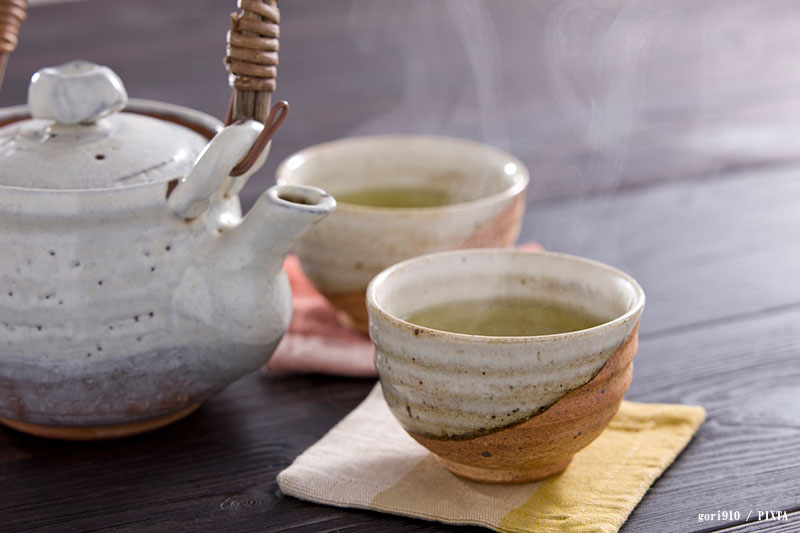
Photo for illustrative purposes
Kissako Wazuka – a hidden tea house with a traditional touch
For those looking to step away from the bustling tourist crowds and experience a quieter, more intimate Kyoto tea experience, Kissako Wazuka is the perfect hidden gem. Tucked away along Ninenzaka and Sannenzaka, this charming tea house captures the peaceful elegance of Kyoto’s old town, offering guests a chance to slow down and enjoy a moment of tranquility.
The experience here is simple but deeply authentic. Guests are invited to sit on traditional tatami mats and enjoy beautifully plated wagashi (Japanese sweets) paired with expertly whisked matcha tea. Unlike modern cafés that blend contemporary flavors into their menu, Kissako Wazuka stays true to Kyoto’s tea culture, serving traditional confections that have been enjoyed for centuries.
- Seasonal wagashi – Inspired by Kyoto’s nature, with sakura-shaped sweets in spring and maple leaf motifs in autumn, making each visit feel special.
There’s no rush here. This is the kind of place where you sit, take a deep breath, and appreciate the artistry behind each sip and bite. If you’re looking for a café that embodies the quiet beauty of Kyoto’s old streets, Kissako Wisteria is a must-visit.
Kissako Wisteria
Address: 5-182 Honmachi, Higashiyama-ku, Kyoto 605-0981, Japan
Business Hours: 11:00 AM – 6:00 PM
Closed: Mondays
Final thoughts
Walking through Ninenzaka and Sannenzaka is more than just sightseeing—it’s stepping into Kyoto’s living history. These old streets of Kyoto, lined with traditional machiya houses and artisan shops, invite you to slow down and experience the city’s timeless charm. Whether you’re holding a handcrafted Kyo-yaki teacup, savoring the rich flavors of Uji matcha, or mastering the delicate folds of a furoshiki, every moment here connects the past and the present. This Ninenzaka Sannenzaka Walking Guide isn’t just about places to visit—it’s about immersing yourself in Kyoto’s old town, where history is felt at every step.
So, as you explore these old streets of Kyoto, take your time. Wander without a plan, peek into hidden alleyways, and let your senses lead you to something unexpected—a taste, a keepsake, or a quiet moment of Kyoto’s magic. This Ninenzaka Sannenzaka Walking Guide is your invitation to embrace the essence of Kyoto’s old town, where every turn tells a story waiting to be discovered. Umami bites is here to guide your journey for more insights, café recommendations, and hidden gems across Japan.
